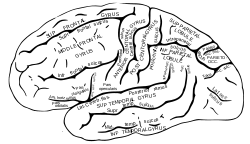| Lunate sulcus | |
|---|---|
 Lateral surface of left cerebral hemisphere, viewed from the side. | |
| Details | |
| Location | Occipital lobe |
| Function | Sulcus |
| Identifiers | |
| Latin | sulcus lunatus |
| NeuroLex ID | birnlex_4017 |
| TA98 | A14.1.09.134 |
| TA2 | 5483 |
| FMA | 83788 |
| Anatomical terms of neuroanatomy | |
In brain anatomy, the lunate sulcus or simian sulcus, also known as the sulcus lunatus, is a fissure in the occipital lobe[1] variably found in humans and more often larger when present in apes and monkeys.[2] The lunate sulcus marks the transition between V1 and V2, the primary and secondary visual cortices.[3]
The lunate sulcus lies further back in the human brain than in the chimpanzee's.[4] The evolutionary expansion in humans of the areas in front of the lunate sulcus would have caused a shift in the location of the fissure.[4][5] Evolutionary pressures may have resulted in the human brain undergoing internal reorganization to develop the capability of language.[6] It has been speculated that this reorganization is implemented during early maturity and is responsible for eidetic imagery in some adolescents.[6]
During early development, the neural connections in the prefrontal cortex and posterior parietal lobe rapidly expand to allow capability for human language, while visual memory capacity of human brain would become limited.[7] Biological studies have demonstrated that the lunate sulcus is subject to white matter growth, and dental fossil and tomography studies have shown that the brain organization of Australopithecus africanus is pongid-like.[8]
- ^ Allen JS, Bruss J, Damasio H (August 2006). "Looking for the lunate sulcus: a magnetic resonance imaging study in modern humans". Anat Rec A. 288 (8): 867–76. doi:10.1002/ar.a.20362. PMID 16835937.
- ^ Srijit D, Shipra P (2008). "Unilateral absence of the lunate sulcus: an anatomical perspective". Rom J Morphol Embryol. 49 (2): 257–8. PMID 18516336.
- ^ Schmolesky, M. "The organization of the retina and visual system".
{{cite journal}}: Cite journal requires|journal=(help) - ^ a b Rincon, Paul (2004). "Human brain began evolving early". BBC.
- ^ Bruner, E (2014). Human paleoneurology. Springer.
- ^ a b Ko, Kwang Hyun (2015). "Brain Reorganization Allowed for the Development of Human Language: Lunate Sulcus". International Journal of Biology. 7 (3): 59. doi:10.5539/ijb.v7n3p59.
- ^ Gogtay, N (2004). "Dynamic mapping of human cortical development during childhood through early adulthood". Proceedings of the National Academy of Sciences. 101 (21): 8174–8179. doi:10.1073/pnas.0402680101. PMC 419576. PMID 15148381.
- ^ Dean, C (2001). "Growth processes in teeth distinguish modern humans from Homo erectus and earlier hominins". Nature. 414 (6864): 628–631. Bibcode:2001Natur.414..628D. doi:10.1038/414628a. PMID 11740557. S2CID 4428635.